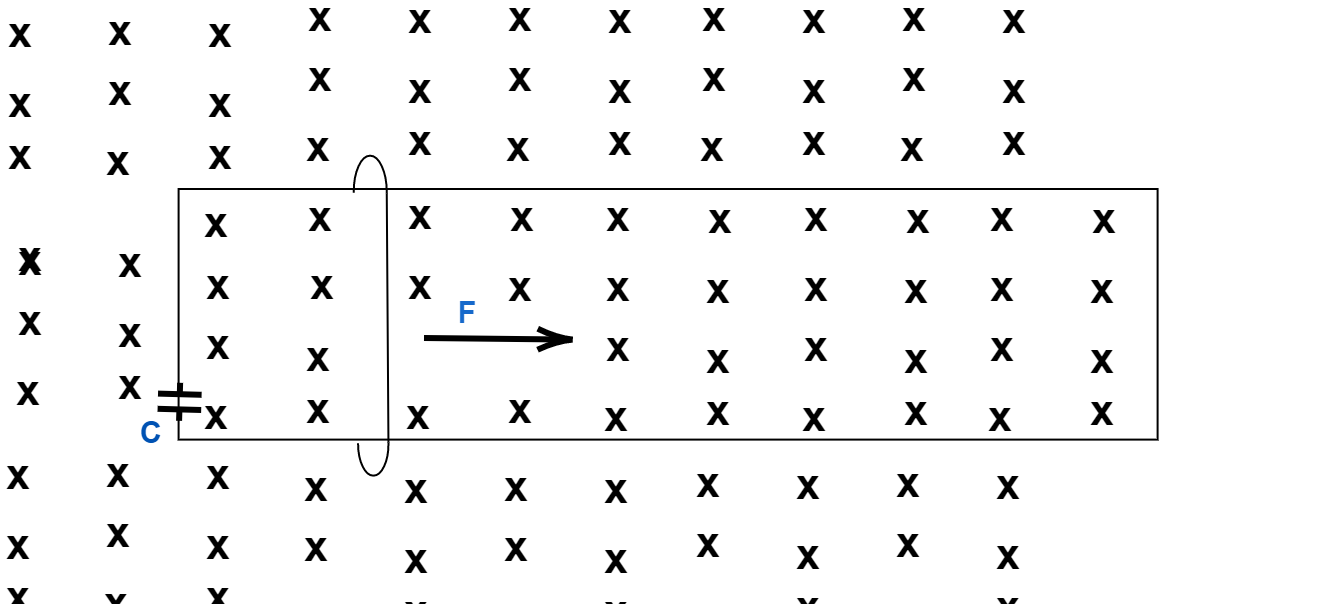
A wire having mass m and length l can freely slide on a pair of parallel smooth horizontal rails placed in vertical magnetic field B. The rails are connected by a capacitor of capacitance C. The electric resistance of the rails and wires is zero. If constant force F acts on the wire as shown in the figure. Then acceleration of the wire can be given as-
(A) $a = \dfrac{{{C^{ - 2}}{B^2}l - F}}{m}$
(B) $a = \dfrac{F}{{CBl + m}}$
(C) $a = \dfrac{{F{C^2}{B^2}l}}{m}$
(D) $a = \dfrac{F}{{m + C{B^2}{l^2}}}$

Answer
221.1k+ views
Hint When the wire is slid along the rails, an e.m.f. is developed in it. This difference in potential causes the capacitor to store a charge. The rate of change of this charge with respect to time gives the current flowing through the capacitor. This can be used to calculate the force on the wire and the net force is divided by m to give the value of acceleration.
Complete step by step answer:
The movement of the conductor perpendicular to a magnetic field produces an e.m.f. in it.
This e.m.f is given by-
$\varepsilon = Bvl$
Where B is the intensity of the Magnetic field.
v is the velocity of the wire
And l is the length of the wire.
This movement causes a flow of charge and this charge is stored in the capacitor.
Charge stored in a capacitor is given by-
$Q = CV$
Here V is the potential difference, which is equal to the produced e.m.f. $\varepsilon $.
Putting the value of $\varepsilon $here, we have-
$Q = C(Bvl)$
The rate of flow of charge is known as current, it can be obtained by differentiating the charge with respect to time.
Therefore,
$i = \dfrac{{dQ}}{{dt}} = BCl\left( {\dfrac{{dv}}{{dt}}} \right)$
The term $\dfrac{{dv}}{{dt}}$ is the acceleration of the wire, which can be represented by a therefore the current flow in the wire can be written as-
$i = BCla$
The same current also passes in the wire, so magnetic force $\left( {{F_b}} \right)$ can be given by-
${F_b} = Bil$
${F_b} = B(BCla)l$
${F_b} = {B^2}C{l^2}a$
This makes the total forces acting on the wire two. On balancing the net force can be given by-
${F_{net}} = F - {F_b}$
$ma = F - {B^2}{l^2}Ca$
On rearranging,
$F = a(m + {B^2}{l^2}C)$
Therefore the acceleration is given by-
$a = \dfrac{F}{{m + {B^2}{l^2}C}}$
Hence, option (D) is correct.
Note: The currents in both wires are assumed to be equal because there is a mention about no losses in the question, generally inductance has very less amount of losses but there is always a loss associated with a device.
Complete step by step answer:
The movement of the conductor perpendicular to a magnetic field produces an e.m.f. in it.
This e.m.f is given by-
$\varepsilon = Bvl$
Where B is the intensity of the Magnetic field.
v is the velocity of the wire
And l is the length of the wire.
This movement causes a flow of charge and this charge is stored in the capacitor.
Charge stored in a capacitor is given by-
$Q = CV$
Here V is the potential difference, which is equal to the produced e.m.f. $\varepsilon $.
Putting the value of $\varepsilon $here, we have-
$Q = C(Bvl)$
The rate of flow of charge is known as current, it can be obtained by differentiating the charge with respect to time.
Therefore,
$i = \dfrac{{dQ}}{{dt}} = BCl\left( {\dfrac{{dv}}{{dt}}} \right)$
The term $\dfrac{{dv}}{{dt}}$ is the acceleration of the wire, which can be represented by a therefore the current flow in the wire can be written as-
$i = BCla$
The same current also passes in the wire, so magnetic force $\left( {{F_b}} \right)$ can be given by-
${F_b} = Bil$
${F_b} = B(BCla)l$
${F_b} = {B^2}C{l^2}a$
This makes the total forces acting on the wire two. On balancing the net force can be given by-
${F_{net}} = F - {F_b}$
$ma = F - {B^2}{l^2}Ca$
On rearranging,
$F = a(m + {B^2}{l^2}C)$
Therefore the acceleration is given by-
$a = \dfrac{F}{{m + {B^2}{l^2}C}}$
Hence, option (D) is correct.
Note: The currents in both wires are assumed to be equal because there is a mention about no losses in the question, generally inductance has very less amount of losses but there is always a loss associated with a device.
Recently Updated Pages
[Awaiting input: Please provide the content from "Ask AI Response," "Competitor 1," and "Competitor 2," so I can perform the analysis and synthesize the requested metadata and headings.]

Young’s Double Slit Experiment Derivation Explained

A square frame of side 10 cm and a long straight wire class 12 physics JEE_Main

The work done in slowly moving an electron of charge class 12 physics JEE_Main

Two identical charged spheres suspended from a common class 12 physics JEE_Main

According to Bohrs theory the timeaveraged magnetic class 12 physics JEE_Main

Trending doubts
JEE Main 2026: Application Form Open, Exam Dates, Syllabus, Eligibility & Question Papers

Derivation of Equation of Trajectory Explained for Students

Hybridisation in Chemistry – Concept, Types & Applications

Understanding the Angle of Deviation in a Prism

How to Convert a Galvanometer into an Ammeter or Voltmeter

Degree of Dissociation: Meaning, Formula, Calculation & Uses

Other Pages
JEE Advanced Marks vs Ranks 2025: Understanding Category-wise Qualifying Marks and Previous Year Cut-offs

Dual Nature of Radiation and Matter Class 12 Physics Chapter 11 CBSE Notes - 2025-26

Ideal and Non-Ideal Solutions Explained for Class 12 Chemistry

Understanding the Electric Field of a Uniformly Charged Ring

Understanding Electromagnetic Waves and Their Importance

Essential Derivations for CBSE Class 12 Physics: Stepwise & PDF Solutions




